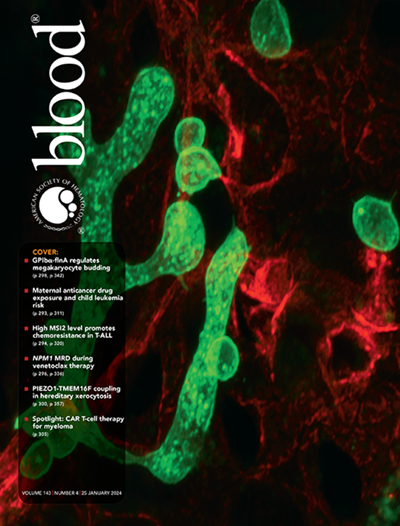A Comprehensive Genetic Study of Classical Hodgkin Lymphoma Using Circulating Tumor DNA.
IF 21
1区 医学
Q1 HEMATOLOGY
引用次数: 0
Abstract
This study analyzed the genetics of classical Hodgkin lymphoma (cHL) by using circulating tumor DNA (ctDNA). Two genetic subtypes were identified, differing in genetic instability mechanisms: one subtype (64% of cases) showed a higher mutation load and a higher fraction of mutations associated with activation-induced cytidine deaminase and microsatellite instability signatures, while the other subtype (36% of cases) exhibited chromosomal instability with more somatic copy number alterations. Whole-genome duplication was more common in cHL compared to other B-cell tumors and emerged as a prognostic biomarker for patients undergoing ABVD-based therapy. Non-coding regulatory mutations, similar to those in diffuse large B-cell lymphoma, were highly prevalent in 86% of cHL. A recurrent somatic expression quantitative trait locus (seQTL) involving the BCL6 gene was found in 30% of cases. The seQTL of BCL6 aligned with accessible chromatin and increased H3K27 acetylation in cHL, disrupted PRDM1 binding, and co-occurred with BCL6 expression in cHL cells. Weak to strong expression of BCL6 was observed in 68% of cases and BCL6 expression associated with gene repression similarly in cHL and germinal center B cells. After BCL6 degradation, the core set of genes directly bound and regulated by BCL6 was derepressed in cHL and proliferation was impaired. The number and clonality of neoantigens was associated with tumor microenvironment type and response to checkpoint blockade. Finally, ctDNA analysis was suggested as a tool to distinguish ambiguous PET/CT-positive lesions post-treatment.循环肿瘤DNA对经典霍奇金淋巴瘤的综合遗传学研究。
本研究利用循环肿瘤DNA (ctDNA)分析了经典霍奇金淋巴瘤(cHL)的遗传学。鉴定出两种遗传亚型,其遗传不稳定性机制不同:一种亚型(64%的病例)表现出更高的突变负荷和与激活诱导的胞苷脱氨酶和微卫星不稳定性特征相关的更高比例的突变,而另一种亚型(36%的病例)表现出更多体细胞拷贝数改变的染色体不稳定性。与其他b细胞肿瘤相比,全基因组复制在cHL中更为常见,并成为接受abvd治疗的患者的预后生物标志物。非编码调节突变,类似于弥漫性大b细胞淋巴瘤,在86%的cHL中非常普遍。在30%的病例中发现涉及BCL6基因的复发性体细胞表达数量性状位点(seQTL)。BCL6的seQTL与可接近的染色质对齐,增加cHL中H3K27的乙酰化,破坏PRDM1的结合,并与cHL细胞中的BCL6表达共存。在68%的病例中观察到BCL6的弱至强表达,并且在cHL和生发中心B细胞中BCL6表达与基因抑制相似。BCL6降解后,cHL中由BCL6直接结合和调控的核心基因组被抑制,增殖受损。新抗原的数量和克隆性与肿瘤微环境类型和对检查点阻断的反应有关。最后,ctDNA分析被建议作为一种工具来区分治疗后的模糊PET/ ct阳性病变。
本文章由计算机程序翻译,如有差异,请以英文原文为准。
求助全文
约1分钟内获得全文
求助全文
来源期刊

Blood
医学-血液学
CiteScore
23.60
自引率
3.90%
发文量
955
审稿时长
1 months
期刊介绍:
Blood, the official journal of the American Society of Hematology, published online and in print, provides an international forum for the publication of original articles describing basic laboratory, translational, and clinical investigations in hematology. Primary research articles will be published under the following scientific categories: Clinical Trials and Observations; Gene Therapy; Hematopoiesis and Stem Cells; Immunobiology and Immunotherapy scope; Myeloid Neoplasia; Lymphoid Neoplasia; Phagocytes, Granulocytes and Myelopoiesis; Platelets and Thrombopoiesis; Red Cells, Iron and Erythropoiesis; Thrombosis and Hemostasis; Transfusion Medicine; Transplantation; and Vascular Biology. Papers can be listed under more than one category as appropriate.
 求助内容:
求助内容: 应助结果提醒方式:
应助结果提醒方式:


